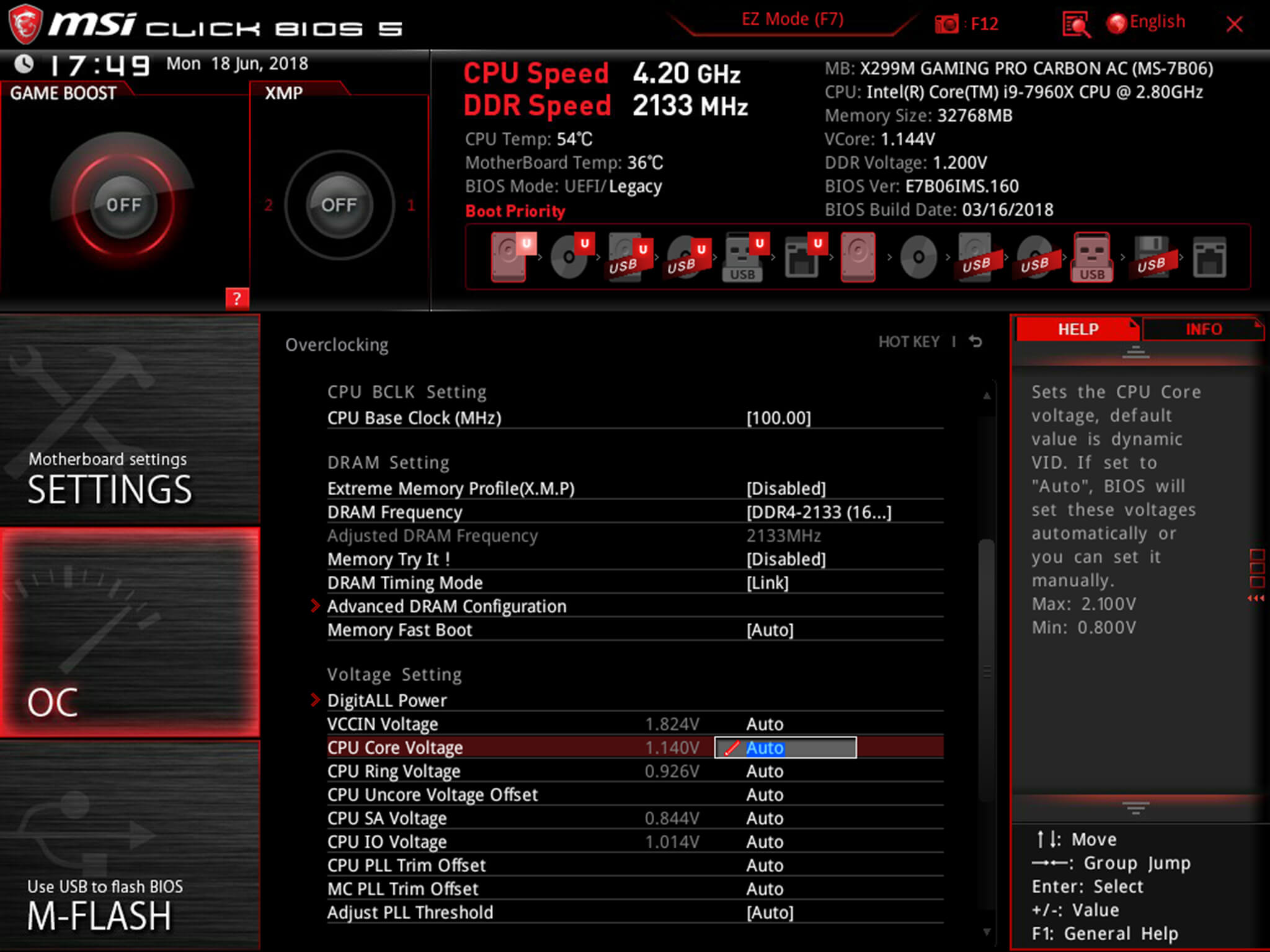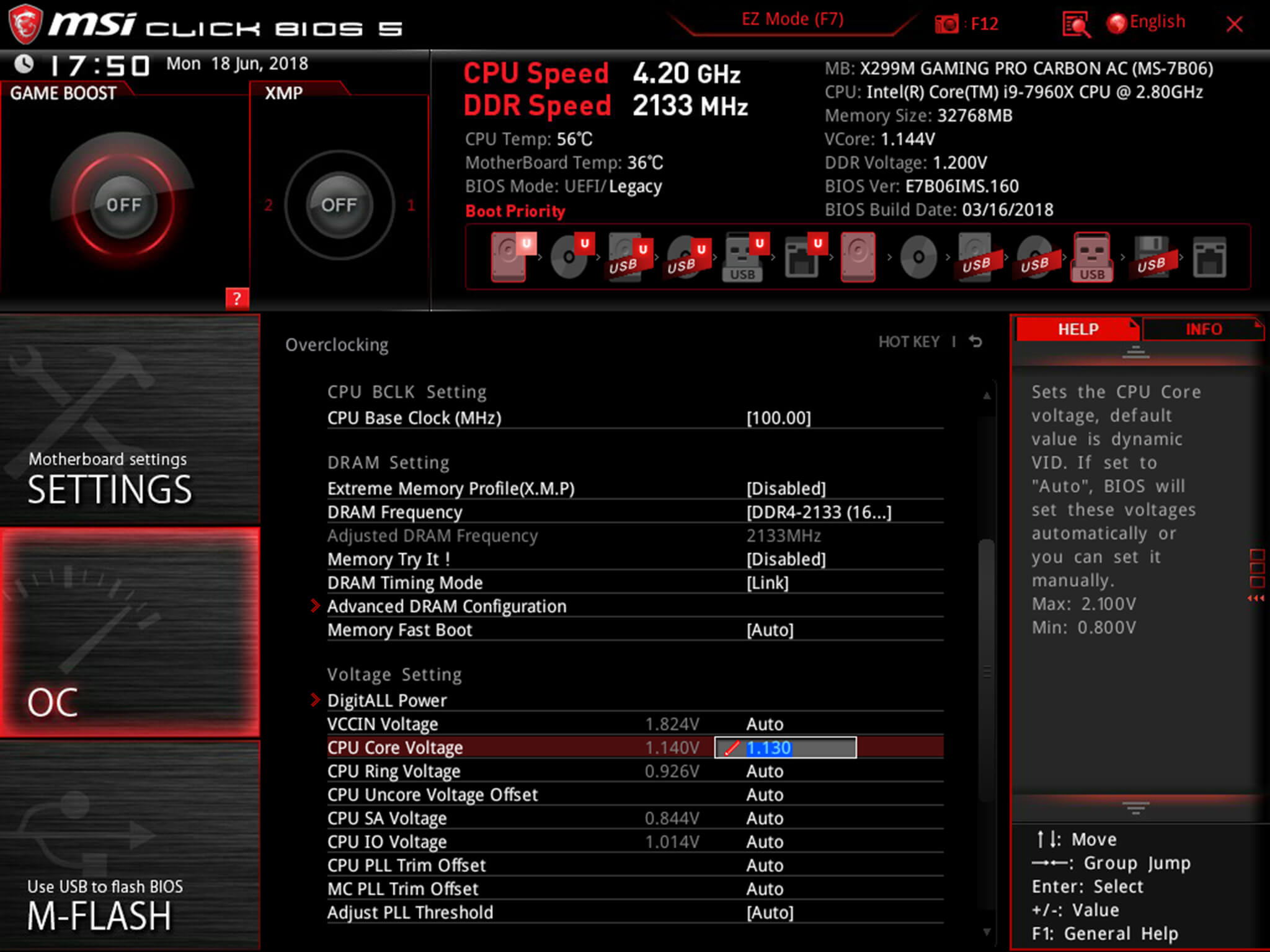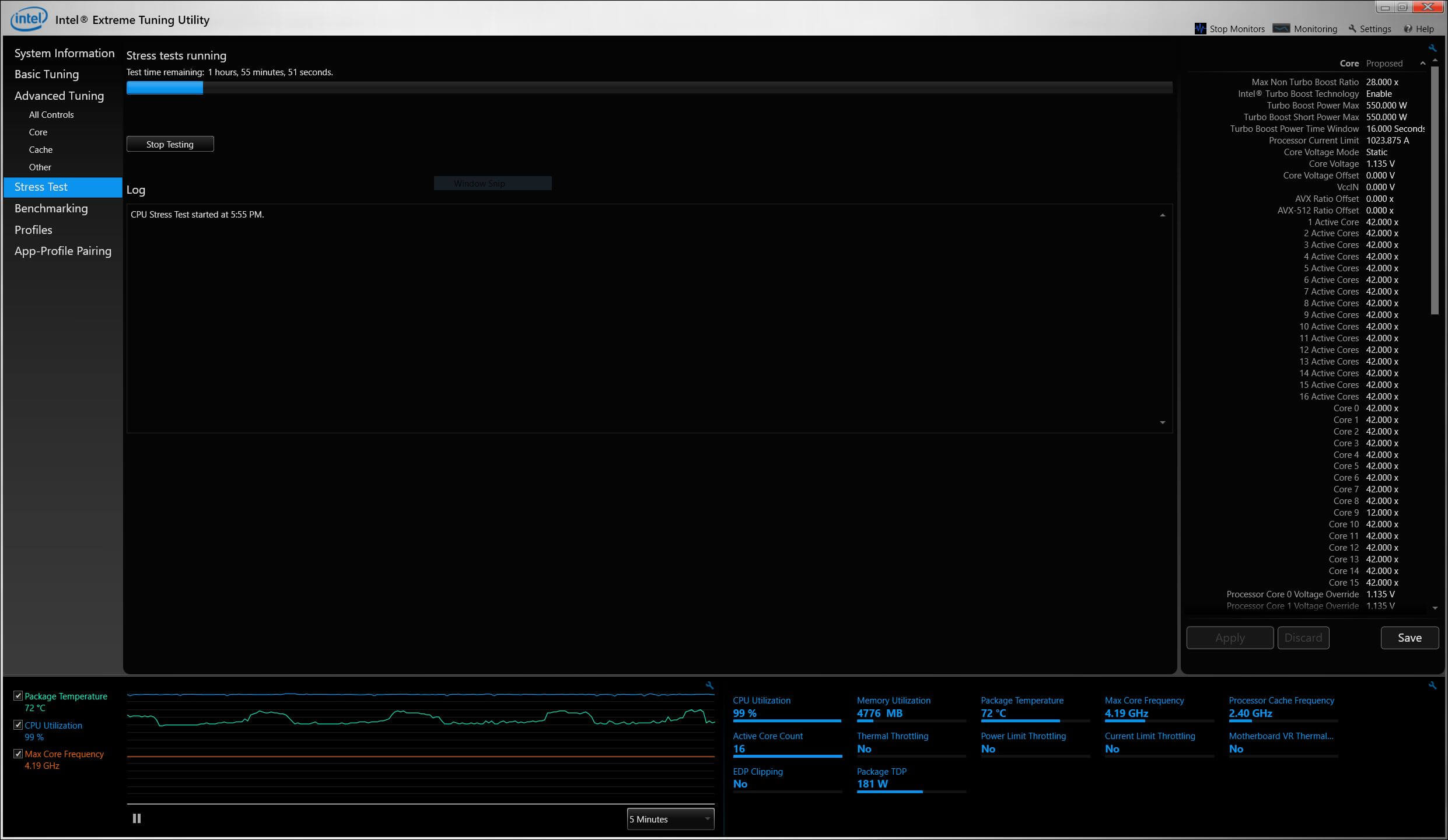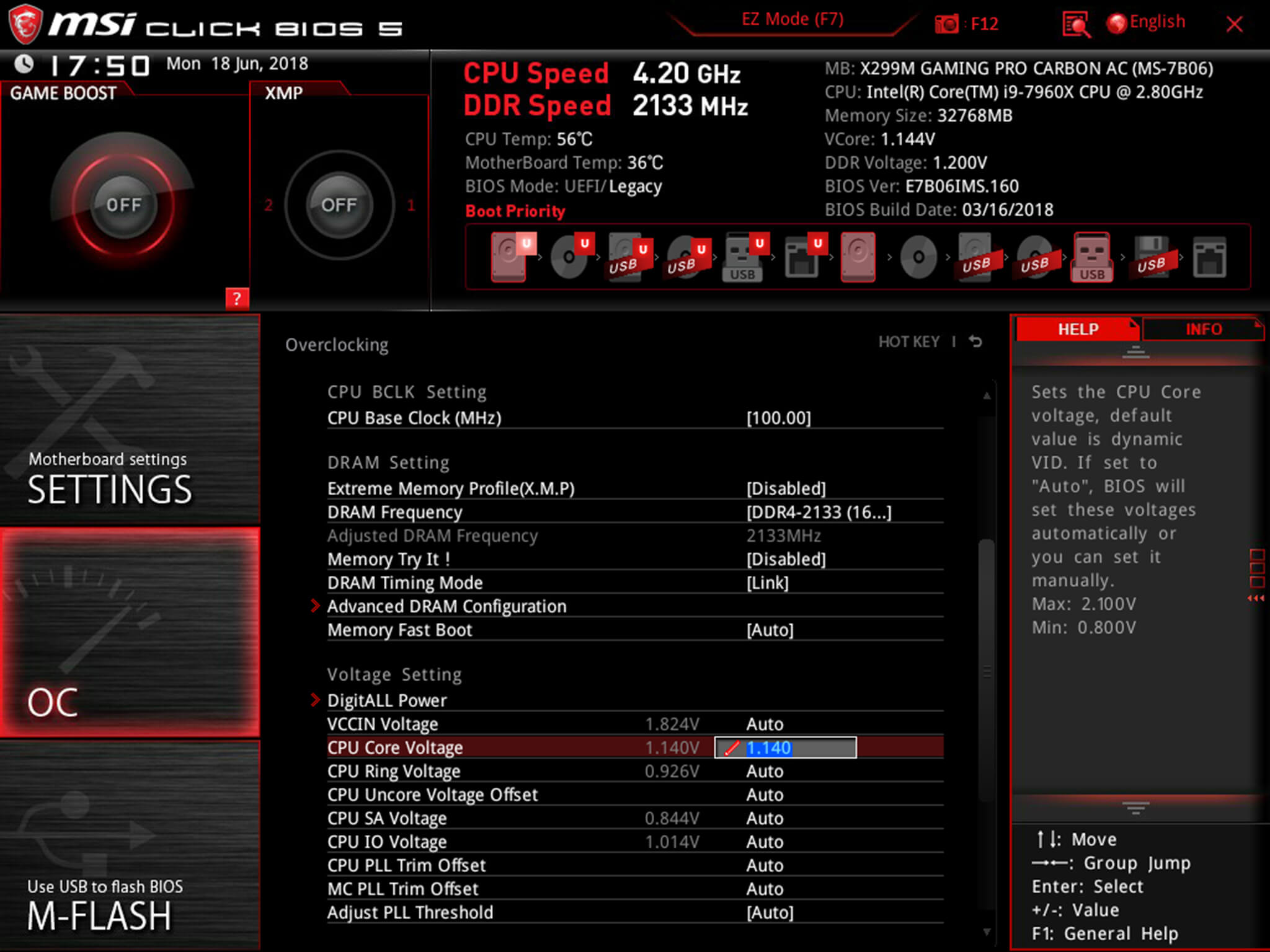The core voltage is different for each processor model, and while all CPUs of the same model have the same VID, not all samples maintain stability at the same clock speeds and Vcore due to slight variations in silicon quality. Every sample of the same CPU model is tested to maintain stability at the default speeds and the VID determined by the manufacturer.
Core voltage typically maintains a constant value while your CPU is in use; however, sometimes under heavy workloads vcore can fluctuate. This is known as Vdroop and can be corrected with load-line calibration. This applies additional voltage as load increases to maintain your CPU's stability.
When it comes to overclocking, you can only push your CPU's frequency so far before your CPU starts to experience instability. Programs might begin to crash or hang up, game performance could suffer or your computer could even fail to boot. This is because your processor isn't getting enough voltage to maintain system stability.
Increasing voltage will allow you to dial in the perfect overclock.
To adjust the voltage, you'll need to boot into your motherboard's BIOS and make adjustments there. The Vcore is expressed as a three decimal value, such as 1.235v. By default, the voltage control is set to auto; this can be overridden by typing in any value. Make sure not to exceed the recommended maximum for your processor.

Before fine-tuning the Vcore, it's important to find a good baseline value for a given speed. This varies from model to model but it can be helpful to read reviews for your CPU, specifically ones that focus on overclocking.
Most publications will list the voltage they required to keep several different speeds stable. Every CPU sample is different and you will need to fine-tune the voltage before calling it done; however, these values do provide a good starting point.

If you boot your machine and don't find any stability issues, then you know it's time to start decreasing the voltage. When overclocking, you want to find the lowest voltage required to maintain stability. More voltage equals more heat and this will allow you to keep temperatures under control.

The safest way to adjust voltage is with increments of .01 volts. Decrease voltage until your computer starts showing signs of instability under load. Use a program like Intel's Extreme Tuning Utility (XTU) or Prime95 to stress test your processor.
If the test fails or crashes, then you need to raise the voltage back up to the previous stable point. For optimal efficiency, you can increase the voltage by .005 instead and again test for stability.

Conversely, if your overclock isn't stable at your baseline voltage, you will then need to increase the voltage until your computer shows no adverse effects and then decrease in increments of .005 to fine tune.

Overclocking is not the only time it can be useful to adjust voltage. As mentioned, higher voltage levels cause your CPU to generate more heat, regardless of frequency. Some CPU samples may have a higher VID than is actually required at the default frequency. Undervolting your processor allows your to maintain stability while decreasing temperatures and extending the life of your processor.
It's a common misconception that disabling Turbo Boost is a more effective substitute for shedding heat. While this does result in decreased temperatures, it is not an alternative as the purpose of undervolting is to maintain the same level of performance while generating less heat. When making adjustments, the same principles apply here as with overclocking, decrease Vcore in increments of .01 and then fine tune with adjustments of .005.
 'Severance' puts a spin on the Orpheus and Eurydice myth in its Season 2 finale
'Severance' puts a spin on the Orpheus and Eurydice myth in its Season 2 finale
 Why masturbation needs to be taught in sex ed
Why masturbation needs to be taught in sex ed
 Woman fights racist workplace dress code with cosplay
Woman fights racist workplace dress code with cosplay
 Why masturbation needs to be taught in sex ed
Why masturbation needs to be taught in sex ed
 Is 'Sing Sing' streaming? How to watch the A24 drama at home.
Is 'Sing Sing' streaming? How to watch the A24 drama at home.
 Miley Cyrus possibly Instagrammed evidence that she married Liam Hemsworth
Miley Cyrus possibly Instagrammed evidence that she married Liam Hemsworth
 Cory Booker answers Donald Trump's hateful tweet with love
Cory Booker answers Donald Trump's hateful tweet with love
 Google search doesn't have political bias, CEO says in internal memo
Google search doesn't have political bias, CEO says in internal memo
 SpaceX lands its first rocket on West Coast ground: Watch
SpaceX lands its first rocket on West Coast ground: Watch
 BBC breaks down investigation into a mass killing in viral Twitter thread
BBC breaks down investigation into a mass killing in viral Twitter thread
 Will the Black Lives Matter moms help Hillary Clinton win?
Will the Black Lives Matter moms help Hillary Clinton win?
 Queen Cersei endorses Michelle Obama for President
Queen Cersei endorses Michelle Obama for President
 The Philadelphia Flyers revealed their new, horrifying mascot, Gritty
The Philadelphia Flyers revealed their new, horrifying mascot, Gritty
 Mac Mini M2 Desktop deal: Save $100 at Best Buy
Mac Mini M2 Desktop deal: Save $100 at Best Buy
 Microsoft announces Cortana Skills Kit for Enterprise
Microsoft announces Cortana Skills Kit for Enterprise
 'Distracted boyfriend' meme is sexist, says Swedish advertising watchdog
'Distracted boyfriend' meme is sexist, says Swedish advertising watchdog
 Shop workers laugh at woman's shorts, she responds with kindness
Shop workers laugh at woman's shorts, she responds with kindness
 Video games should be used to teach sex ed
Video games should be used to teach sex ed
Google Pixel Buds may get customizable tap gesturesElon Musk says Boring Company tunnels are not primarily for carsA list of filmmakers who've committed to inclusion ridersEd Sheeran wows fans with a free gig in Australian lanewayNicolas Cage finally gets to play Superman, in 'Teen Titans GO!'Incredible savings at Amazon on a LG 55When bad music videos happen to good songsJeff Goldblum brings Dr. Ian Malcolm to 'Jurassic World Evolution'Stranger Things' creators respond to on'Ready Player One' review roundup: Dubbed 'the geekiest movie ever made'Hands on with the Bose AR augmented reality sunglassesFrom space, the third nor'easter in 2 weeks is seen pummeling BostonApple patents a crumbApple announces WWDC 18 dates: June 4'The Simpsons' original 'Who Shot Mr. Burns?' pitch was VERY differentThere's a Michael Scott quote to sum up every college majorEd Sheeran wows fans with a free gig in Australian lanewaySony's Interactive Cube puts you in a digital hamster ballApple is buying Texture, a digital magazine subscription service'Black Panther' beats 'The Dark Knight,' closes in on 'The Avengers' 'Game of Thrones' star Lena Headey reveals how she really felt about Cersei's death Cats on Instagram wish you a meowy Christmas and a happy mew year Quintessentially Canadian video shows peckish moose licking salt off car Woman rescues her attacked pup with a tip she learned on Reddit Abstinence Why are these Tinder's most popular names of 2016? Only Google knows Ancestry test customers are sending their DNA data to third Google Calendar scam adds malicious links to your schedule Behind the mysterious stock dump ahead of Trump's Lockheed Martin tweet Spotify's new 'Your Daily Drive' playlist is like FM radio Jennifer Aniston reunites with Adam Sandler for 'Murder Mystery' Byton’s massive 48 Report explains the privacy issues of wearable health data collection Instagram is down in parts of the U.S., South America, and Europe 'Cadence of Hyrule' is a fantastically catchy take on 'Zelda' NASA spots a telltale 'Star Trek' sign on Mars 'Game of Thrones' score hinted at alternate ending for Jaime and Brienne 'Toy Story 4' justifies its own existence by questioning it: Review Adult toy store employees fight off armed robber by throwing dildos at him 15 times Carpool Karaoke was the perfect antidote to 2016
2.0256s , 10133.359375 kb
Copyright © 2025 Powered by 【My Sinful Valentine XXX】,Charm Information Network